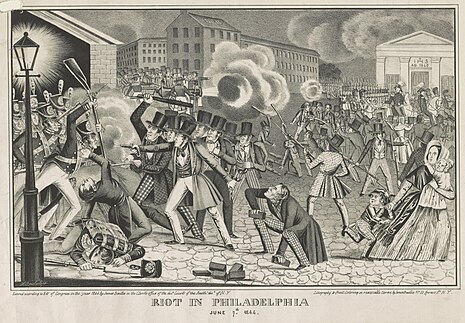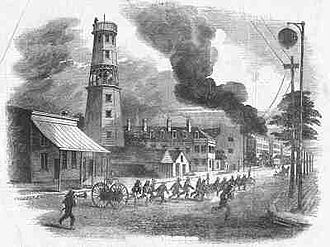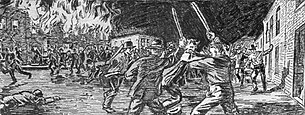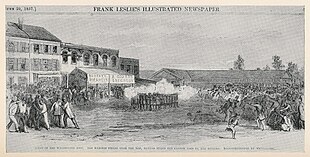| It has been suggested that this article be merged with Baltimore Know-Nothing riots of 1856. (Discuss) Proposed since December 2024. |
The term Know-Nothing Riot has been used to refer to a number of political uprisings of the Know Nothing Party in the United States of the mid-19th century. These anti-immigrant and anti-Catholic protests culminated into riots in Philadelphia in 1844; St. Louis in 1854, Cincinnati and Louisville in 1855; Baltimore in 1856; Washington, D.C., and New York City in 1857; and New Orleans in 1858.

Philadelphia 1844
Main article: Philadelphia nativist riotsThe Philadelphia nativist riots took place on May 6—8 and July 6—7, 1844, in Philadelphia, and the adjacent suburbs of Kensington and Southwark. The riots were a result of rising anti-Catholic sentiment at the growing population of Irish Catholic immigrants. The government brought in over a thousand militia—they confronted the nativist mobs and killed or wounded hundreds of anti-Catholic rioters.
In the five months leading to the riots, nativist groups had been spreading a false rumor that Catholics were trying to remove the Bible from public schools. A nativist rally in Kensington erupted in violence on May 6 and started a deadly riot that would result in the destruction of two Catholic churches and numerous other buildings. Riots erupted again in July after it was discovered that St. Philip Neri's Catholic Church in Southwark had armed itself for protection. Fierce fighting broke out between the nativists and the soldiers sent to protect the church, resulting in numerous deaths and injuries. Two of the 13 Catholic churches were burned. The Catholic Church sued the city and won some money for repairs. Civic leaders deplored the nativist attacks. Nationally, the riots helped fuel criticism of the nativist movement, despite denials of responsibility from nativist groups. The riots exposed deficiencies in law enforcement in Philadelphia and the surrounding districts, influencing various reforms in local police departments and the eventual consolidation of the city in 1854.
St. Louis 1854
In August 1854 a major election riot exploded in St. Louis, Missouri, a city of 95,000 population. It was caused by the escalation of tensions between Irish Catholic Democrats and the anti-immigrant Know-Nothing movement. Violence came when Know-Nothing activists brought a local judge to the polls and he rejected Irishmen who could not prove their citizenship. Fighting broke out across the inner city, and ended only when 500 armed state militia took control. Ten men were killed and 33 wounded; 93 buildings were damaged by arson. The episode reflected multiple forces at work, including rapid immigration from Europe, the success of local Irish politicians, the nationwide nativist movement, the policies of Democratic Mayor John How, and the bitterly fought contest for House of Representatives between Whig Luther Martin Kennett and Democrat Thomas Hart Benton.

Cincinnati 1855
The Election Day Riots of 1855 occurred in Cincinnati between April 2–7, 1855. The election was between James J. Faran, the Democratic contender and editor of the Cincinnati Enquirer, and James D. Taylor, rabid nativist editor of the Cincinnati Times. Rumors of illegal voting, ballot-box stuffing, and naturalized voters preventing native-born citizens from voting sparked the events.

Louisville 1855
Main article: Bloody MondayBloody Monday was a series of riots on August 6, 1855, in Louisville, Kentucky, an election day, when Protestant mobs attacked Irish and German Catholic neighborhoods. These riots grew out of the bitter rivalry between the Democrats and the Nativist Know-Nothing Party. Multiple street fights raged, leaving twenty-two people dead, scores injured, and much property destroyed by fire. Five people were later indicted, but none were convicted, and the victims were not compensated.
Baltimore 1856
Main article: Baltimore Know-Nothing riots of 1856The riots occurred in Baltimore, Maryland between September and November of that presidential election year. The Know-Nothing Party gained traction in Baltimore as native-born residents feared the rapidly growing Irish and German immigrant population. Local street gangs became divided on political grounds, with the Know-Nothing affiliated gangs clashing with gangs affiliated with the Democratic Party. The partisans were involved in widespread violence at the polls and across Baltimore during municipal and national elections.

Washington D.C. 1857
Know-Nothing associated gang, the Plug Uglies, had travelled to Washington. D.C.. from Baltimore on June 1, 1857, in an attempt to prevent German and Irish immigrants from voting in the local election. The Plug Uglies linked up with allied members of the Rip Raps and the Chunkers and moved to Mount Vernon Square to harass anti-Know Nothing voters. They then returned to the square armed with pistols, clubs, bricks, and other weapons and charged into the crowd of voters. A brutal fight broke out which the police were unable to stop and by noon, President Buchanan had called out two companies of Marines to stop the riot. By the time the Marines arrived at Mount Vernon Square, the Know-Nothings had set up a barricade and were armed with a cannon they had taken from the Navy Yard. Archibald Henderson, Commandant of the Marine Corps, marched up to the cannon and placed his body in front of it so it could not be aimed at his men. This allowed the Marines to advance on their position, but a fire fight soon broke out. Eight people were killed by the end of the day and at least 15 were injured.

New York City 1857
Main article: Dead Rabbits riotNew Orleans 1858
The New Orleans Know-Nothing group began as a local movement in 1858 to reduce what residents considered a high rate of crime and violence in the city, primarily among Irish and German immigrants, who were among the poorest classes. A secret Vigilance Committee was formed to monitor their activities, and in particular to prevent disruption of upcoming municipal elections.
On the night of June 2, 1858, armed men under the command of Capt. J.K. Duncan, an officer in the United States Army, marched to Jackson Square and occupied the court rooms in The Cabildo. For the next five days, a standoff existed between the Vigilance Committee and members of the Native American Party. On June 7, the elections were held and the Native American candidate, Gerard Stith, defeated the Democratic Party candidate, P.G.T. Beauregard. The Vigilance Committee disbanded with no further violence.
Notable Know Nothing criminal gang rioters
- American Guards (New York City)
- Atlantic Guards (New York City)
- Blood Tubs (Baltimore and Philadelphia)
- Bowery Boys (New York City)
- Killers (Philadelphia)
- O'Connell Guards (New York City)
- Plug Uglies (Baltimore, Philadelphia, and New York City)
- Rip Raps (Baltimore)
- Roach Guards (New York City)
- Shifflers (Philadelphia)
See also
- Know-Nothing Party
- Anti-Catholicism in the United States
- List of incidents of civil unrest in the United States
References
- Patrick Grubbs, "Riots (1830s and 1840s)" Encyclopedia of Greater Philadelphia (2018)
- Luke Ritter, "The St. Louis Know-Nothing Riot of 1854: Political Violence and the Rise of the Irish." Gateway Heritage Magazine 32 (2012): 27-35.
- James Neal Primm, Lion of the Valley: St. Louis, Missouri, 1764-1980 (1998) pp. 175-179.
- Alfred G. Stritch, "Political Nativism in Cincinnati, 1830-1860." Records of the American Catholic Historical Society of Philadelphia 48.3 (1937): 227-278. online
- William E. Gienapp, The Origins of the Republican Party, 1852–1856 (1978),
- Wallace S. Hutcheon Jr.. "The Louisville Riots of August, 1855" Register of the Kentucky Historical Society 69#2 (1971) pp.150–72. online
- Benjamin R. Tuska, "Know-Nothingism in Baltimore 1854-1860". Catholic Historical Review (1925) 11 (2): 217–251 online
- Frank Towers, "Violence as a tool of party dominance: election riots and the Baltimore know-nothings, 1854-1860." Maryland Historical Magazine 93 (1998): 5-37.
- "The Election Day Riot of 1857, driven by religious intolerance". 15 December 2015. Retrieved 2021-12-08.
- Proctor, John Clagett (1932-09-25). "Account of 1857 riot". Evening star. p. 75. Retrieved 2023-12-29.
- "New-Orleans Vigilance Committee - Tems of Settlements", nytimes.com, June 4, 1858.
Further reading
Further information: Nativism (politics) in the United States § Bibliography- Anbinder, Tyler. "Nativism and prejudice against immigrants," in A companion to American immigration, ed. by Reed Ueda (2006) pp. 177–201 online excerpt
- Baker, Jean H. (1977), Ambivalent Americans: The Know-Nothing Party in Maryland, Baltimore: Johns Hopkins.
- Bennett, David H. The Party of Fear: From Nativist Movements to the New Right in American History (1988) online
- Billington, Ray A. The Protestant Crusade, 1800–1860: A Study of the Origins of American Nativism (1938), standard scholarly survey; online
- Boissoneault, Lorraine. "How the 19th-Century Know Nothing Party Reshaped American Politics." Smithsonian Magazine (2017), heavily illustrated with editorial cartoons. online
- Farrelly, Maura Jane. Anti-Catholicism in America, 1620–1860 (Cambridge University Press, 2017) .
- Gienapp, William E. "Nativism and the Creation of a Republican Majority in the North before the Civil War," Journal of American History, Vol. 72, No. 3 (Dec., 1985), pp. 529–559 in JSTOR
- Gienapp, William E. The Origins of the Republican Party, 1852–1856 (1978), detailed statistical study, state-by-state, with extensive coverage of local elections
- Haebler, Peter. "Nativist Riots in Manchester: An Episode of Know-Nothingism in New Hampshire." Historical New Hampshire 39 (1985): 121–37.
- Holt, Michael F. "The Antimasonic and Know Nothing Parties", in Arthur Schlesinger Jr., ed., History of United States Political Parties (1973), I, 575–620.
- Lee, Erika. America for Americans: A history of xenophobia in the United States (Basic Books, 2019) online.
- McGreevey, John T. Catholicism and American Freedom: A History (W. W. Norton, 2003)
- Maizlish, Stephen E. "The Meaning of Nativism and the Crisis of the Union: The Know-Nothing Movement in the Antebellum North." in William Gienapp, ed. Essays on American Antebellum Politics, 1840–1860 (1982) pp. 166–98
- Melton, Tracy Matthew (2005). Hanging Henry Gambrill: The Violent Career of Baltimore's Plug Uglies, 1854-1860. Maryland Historical Society. ISBN 0938420933.
- Mulkern, John R. The Know-Nothing Party in Massachusetts: The Rise and Fall of a People's Movement. Boston: Northeastern UP, 1990. excerpt
- Ramet, Sabrina P., and Christine M. Hassenstab. "The Know Nothing Party: Three Theories about its Rise and Demise." Politics and Religion 6.3 (2013): 570–595.
- Smith, John Kendall (1922). A History of New Orleans. Chicago: Lewis Pub. Co.
- Voss-Hubbard, Mark. Beyond Party: Cultures of Antipartisanship in Northern Politics before the Civil War (2002)
- Wilentz, Sean. The Rise of American Democracy. (2005); ISBN 0-393-05820-4
- 1854 in the United States
- 1857 in the United States
- 1858 in Louisiana
- 1854 riots
- 1858 riots
- Riots and civil disorder in Missouri
- Riots and civil disorder in Louisiana
- Political riots in the United States
- 1857 in Washington, D.C.
- 1854 in Missouri
- Crimes in New Orleans
- June 1857 events
- June 1858 events
- 19th century in New Orleans
- Know Nothing